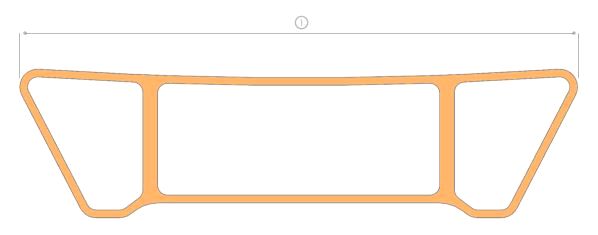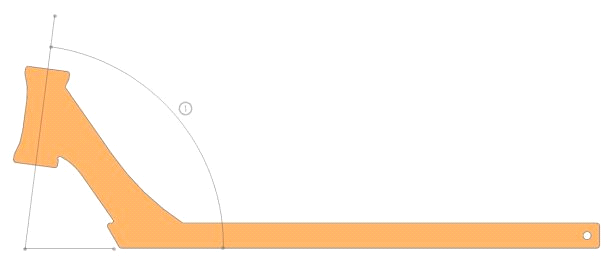Stunt Scooter Deck
The "Deck" of a freestyle scooter is the most important part of a scooter, it has the greatest impact on the performance and riding feeling. Over the last 10 years, the development in the deck market has been rapid and extremely developed. In 2008/2009, most decks were still equipped with a folding mechanism to keep the scooter portable. Nowadays, scooter decks are much more stable and new improvements have been made to make a deck more durable.
The deck is a combination of several components: the head tube (in which the fork is inserted), the aluminium cover plate and a component to connect these two parts. There are 3 ways to connect these two parts:
Lower tube: a single tube that connects the top plate and the head tube in different sections (round, triangular or trapezoidal), the lower tube is welded to the top of the cover plate or passes through the top and is welded at the top and bottom, or is screwed.
Neck Plates : Two identical plates, each attached to the top plate and head tube, are often stiffened with additional spacers.
Combination of the two: This variant uses both the drop tube mechanism and the flange plate mechanism. Here the down tube is attached to the head tube, the flange plate is welded to the cover plate and the two fit together and are sometimes additionally fixed with screws.
In all developments and improvements, however, it should never be forgotten that a chainring is a highly stressed product and that every product also shows signs of wear. This means that a deck can scratch, bend, rub and of course break! In the scooter industry, it is common for a deck to have exceeded its service life after 5 to 6 months of frequent riding. As it can be excluded that after more than 3 months of use of the deck, material weaknesses can explain the above mentioned problems, the warranty of decks as well as other manufacturer's parts is limited depending on the brand.
We strive to choose brands with an excellent after-sales service in order to best serve our customers.
Weight of the freestyle scooter deck
When we talk about deck, we often talk about weight. The weight distribution on the deck greatly influences the riding characteristics of the scooter. Theoretically, it is possible to build an indestructible deck, but the weight would be anything but significant and therefore impossible to ride. In theory, the heavier the deck, the more stable it is (due to the thickness of the material). In reality, however, you can make a 1200g deck more stable than an 1800g model. Geometry, materials, chemical treatment and production quality are important factors when making a deck. A heavier deck gives you more stability in the air than a lighter deck, but a lighter deck reacts much faster. If you switch from a light deck to a heavy deck (or vice versa), you have to keep in mind that it behaves completely differently and you have to get used to it. Don't focus on the total weight. If your deck is "heavy on the tail", the fulcrum will be closer to you, almost as if the center of gravity is in the center. Heavier decks "heavy on the front" will behave as if they were spinning around the fork. It's up to you to decide what suits you best, it's a matter of personal preference, nothing is better or worse, until you find "your" deck, you have to try a lot of them.
Optimal deck dimensions
Length
The length of the board is also an important factor and has a significant impact on your scooter. You should not include the head tube and bottom tube (or neck plates) if you are measuring the deck, only the chainring. A short deck is suitable for young or small riders. Turning the deck is much easier with a short deck, but the aesthetic aspect suffers a little. A long deck turns slower, but it gives you more stability and a grip surface. In addition, a long deck gives you more "pop", which means you can easily make high jumps. Because the wheels are further apart, you also need more weight. One more thing: a long deck is heavier, so it is more difficult to build a long and stable deck than a short one. Keep these points in mind when choosing a long deck and choose your brand carefully.
Width
Concavity has been present on the scooter decks since 2009. Previously, all decks were completely flat. The concave is usually measured in degrees and indicates the degree of curvature of the top. This shape has been taken over by skateboards, your feet simply grip better on this shape of the deck. You will also have more grip on Whips, which are easier to catch because the edges of the deck are higher than the rest of the board. This will help your foot to catch both edges of the deck after a TailWhip.
Headtube Angle
Since monobloc decks have been on the market, many angles have been tested. The most common angle is 82.5°, but there are also decks with angles between 81° and 83°. Head tube angles are also measured in degrees. The angle is also important for the overall "feel" of a scooter, it determines the position of the rider. With an angle of 83° the handlebars are more vertical and you have more room for rotation. The angle, as well as weight and height, is a matter of personal taste - there is no "best" angle.
Headtube
1 : bearing
2 : bowl
3 : headtube
There are three types of headset:
In the long run, the first type will only be found in entry-level scooters, as the bowls have to be adjusted by hand, which is detrimental to aesthetics and weight. This type of head tube is mainly used for beginner decks. Since 2009, there are decks for integrated headsets, TSI was the first company to introduce this innovation. Just put the ball bearings on the head tube and you're done! Since the production of such decks is significantly more expensive than standard decks, the integrated technology is usually used in "high-end" products. The disadvantage: There are no standard sizes of ball bearings. The most common is 41.8 x 45°. This number is engraved on the ball bearings. Be sure to use the correct headset when buying a new deck.
Forged Technology
This technology was the first to see the light of day in 2011 in the world of scooters, Envy (formerly Blunt) were the pioneers in this field. Normally, a deck consists of three elements that are welded together. For a forged deck, the head tube and deck are made from a single piece of aluminium. They are "geo-formed" together: the material is first compressed under very high pressure and then the part is milled from the aluminium block. This technique is very expensive, so you can only find it on high-end bridges. Forged decks are much more stable because they are more difficult to break at the point between the front and the drop tube. Furthermore, the precision of this method is much higher, normal decks sometimes have production tolerances, which mainly affects the angle of the head tube. A forged deck will never deviate more than 0.2°.
Which deck or deck brand to choose according to the type of ride street or park?
Pour un Street Ride, we favour LONG decks such as : Blunt Didine / long decks from Ethic or Addict
For a Park Ride, we favour SHORT decks such as : short models from Blunt et Ethic / Apex / Fasen / Madd Gear MGP



















